
The Toshiba EMI Recordings / Original Stereo Version
08. Rubber Soul (OP-7450, OP/AP-8156)
(Update: 20th. December 2018)

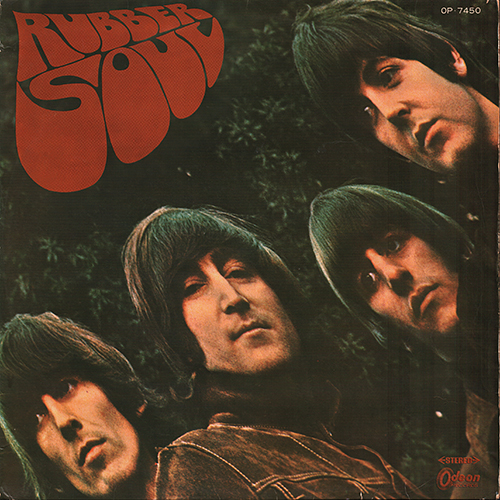 Odeon 1st. Sleeve |
|
| TITLE | RUBBER SOUL |
||||
| CATALOG NUMBER | OP-7450 |
||||
| RELEASE DATE | Promotional
Record
(First Press: 15th March.1966) |
||||
| TRACK LISTING | SIDE 1 | SIDE 2 | |||
| Drive My Car |
What Goes On |
||||
| Norwegian Wood (This Bird Has Flown) |
Girl |
||||
| You Won't See Me |
I'm Looking Through You |
||||
| Nowhere Man |
In My Life |
||||
| Think For Yourself |
Wait |
||||
| The Word |
If I Needed Someone |
||||
| Michelle | Run For Your Life |
||||
| FRONT --> Click! | BACK --> Click! | SIDE 1 --> Click! | SIDE 2 --> Click! | DISK | |
 |
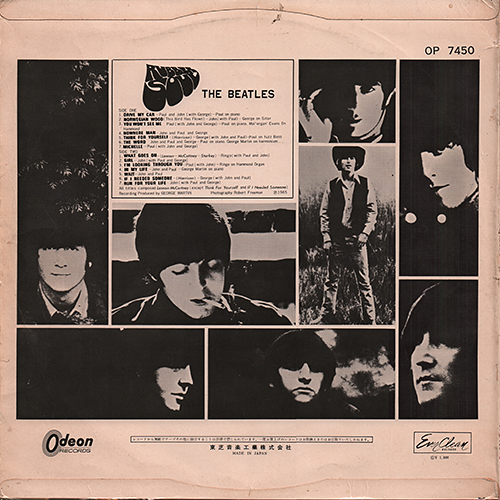 |
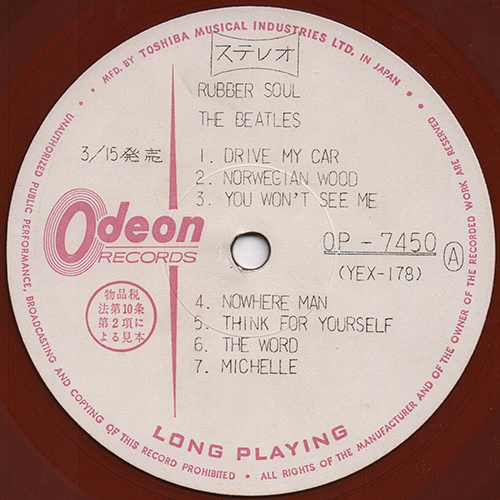 |
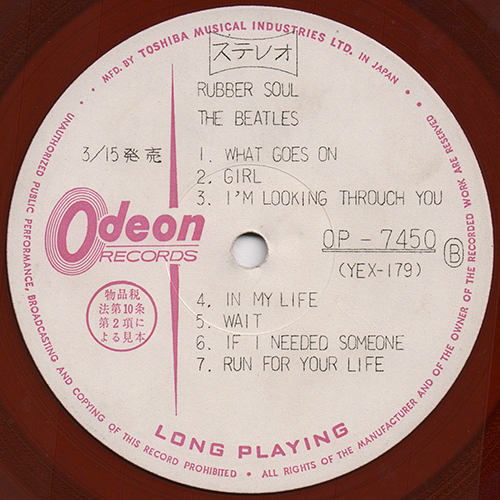 |
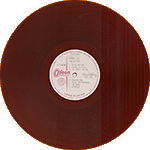 |
|
| INNER SLEEVE |
LYRIC
SHEET (Bifold Type)
|
||||
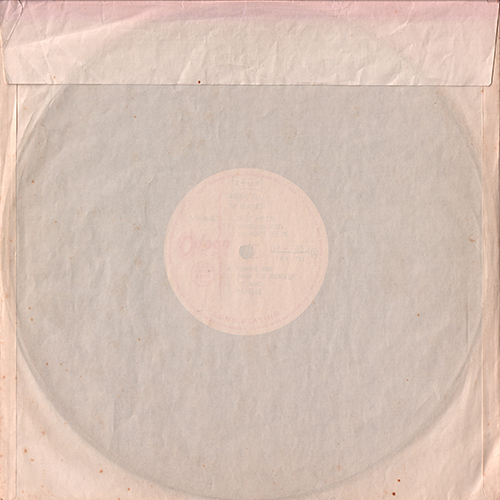 |
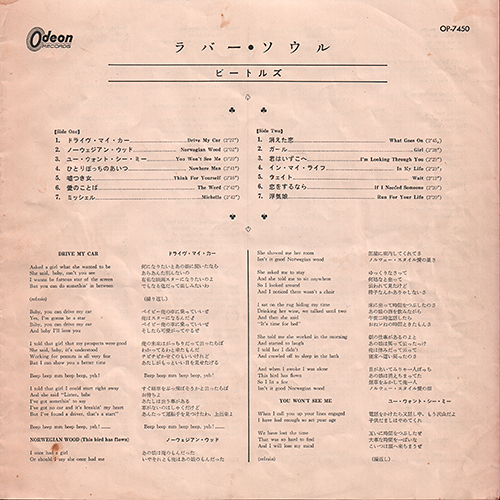 |
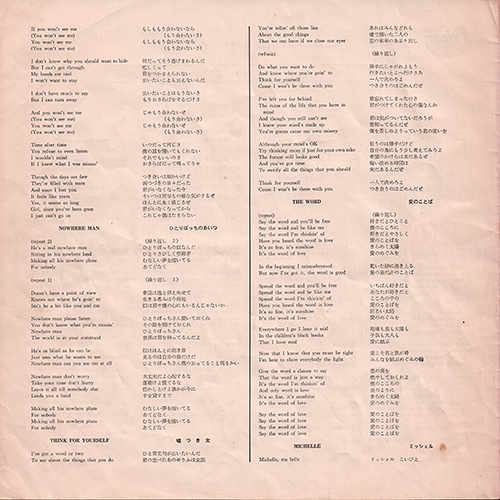 |
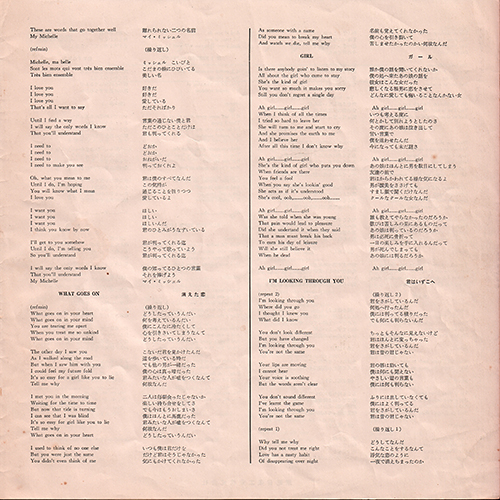 |
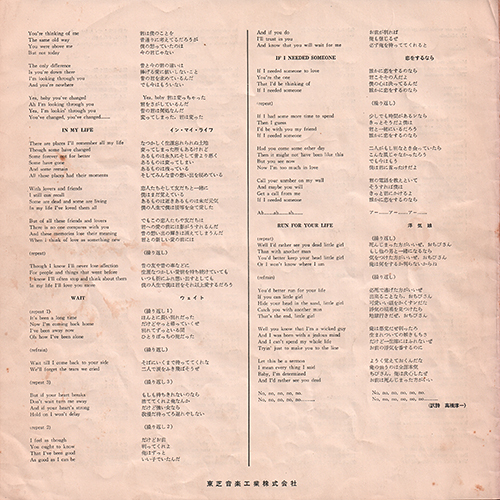 |
|
| LYRIC SHEET CLOSE
UP |
|||||
 |
 |
 |
Translation: Junichi Takahashi. "Toshiba Musical Industries Ltd." was printed on the lyric sheet. |
||
| FRONT COVER CLOSE UP | BACK COVER CLOSE UP | ||||
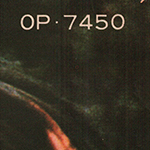 |
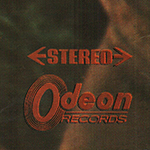 |
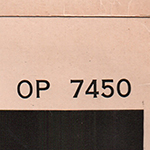 |
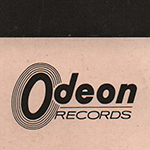 |
Odeon logo mark and catalog number "OR 7450" were printed on both sides of the cover. | |
| BACK COVER CLOSE UP | |||||
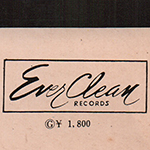 |
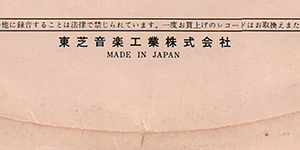 |
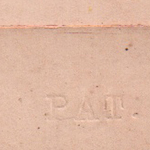 |
"Toshiba Musical Industries
Ltd." and "G-¥1,800" were printed at the bottom of the back
cover. The words "PAT." was embossed at the bottom of the back cover. |
||
| LABEL CLOSE UP | |||||
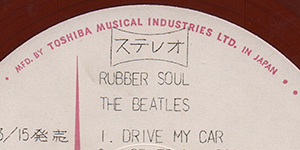 |
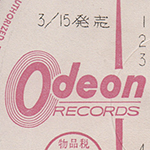 |
Odeon white
label (promotional use only). The words "MFD. BY TOSHIBA MUSICAL INDUSTRIES LTD. IN JAPAN" was printed at the perimeter. The release date is in black and appears above and to the left of the title. |
|||
| LABEL CLOSE UP | |||||
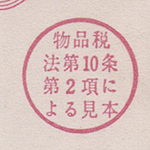 |
Here is a close-up of the circled text: "Sample under Article 10, Clause 2 of the Commodity Tax Law". | 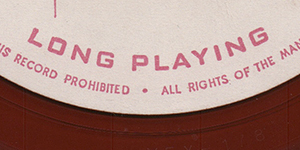 |
The words "LONG PLAYING" was printed at the bottom of the label. | ||
| LABEL CLOSE UP | |||||
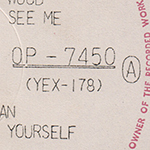 |
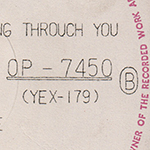 |
The print in
black has unusual "hand lettered" look to it quite unlike
the regular commercial version. Catalog number and matrix number were printed at the right side of the center hole. |
|||
|
OTHER ITEM
|
|||||
| - | |||||
| RECORD LABEL | Odeon White Label (for promotional use
only) |
||||
| MIX | STEREO |
||||
| MATRIX No. | SIDE 1 | YEX-178 2 |
|||
| SIDE 2 | YEX-179
1 |
||||
| PRESS MARK | None |
||||
| VINYL COLOR | RED |
||||
| RECORD COMPANY'S NAME | SLEEVE | Toshiba
Ongaku kogyo Kabusikigaisha |
|||
| LABEL | MFD. BY
TOSHIBA MUSICAL INDUSTRIES LTD. IN JAPAN |
||||
| SYMBOL/PRICE | G - ¥1,800 |
||||
| LYRIC SHEET STYLE | Bifold Type |
||||
| COVER FORM | Single type. Full laminated soft cover. Twin-flipback cover (round type) |
||||
| INNER SLEEVE |
Plain
White Inner bag |
||||
| OBI |
- |
||||
| COVER DESIGN/ PHOTO/ NOTES | Translation: Junichi Takahashi |
||||
|
COMMENTS
|
Odeon white label
(promotional use only). The words "MFD. BY TOSHIBA MUSICAL INDUSTRIES LTD. IN JAPAN" was printed at the perimeter. Odeon promo LPs feature the perimeter print, Odeon logo, and circled text in red and all other printing in "hand lettered" black. Note the release date above the Odeon logo. The label design is similar to that used for the regular commercial Odeon LPs. These are most commonly found on red vinyl. In Japan, promotional records have traditionally been provided at no charge to radio stations, record shops, and the mass media to increase the sales of a record or in some cases to promote a tour. There are two types of promotional releases. Type-1: This type is called the white label promo for which a unique label has been made. The label design of Odeon white label singles is very similar to that of regular commercial Odeon singles. The promo version, however, features the perimeter print, Odeon logo, and circled text in red and all other printing in black. The print in black has an unusual "hand lettered" look to it quite unlike the regular commercial version. The release date is in black and appears above and to the left of the title. Most usually, the regular cover is used with appropriate alterations to prohibit commercial sale. Type-2: The second type of promo record is less elaborate and is called a sticker promo. It is simply a regular commercial release that has a promo sticker affixed to the cover. This type of promo is occasionally found on post-1975 releases. |
||||
| TITLE | RUBBER SOUL |
||||
| CATALOG NUMBER | OP-7450 |
||||
| RELEASE DATE | 15th March.1966 / First Press |
||||
| TRACK LISTING | SIDE 1 | SIDE 2 | |||
| Drive My Car |
What Goes On |
||||
| Norwegian Wood (This Bird Has Flown) |
Girl |
||||
| You Won't See Me |
I'm Looking Through You |
||||
| Nowhere Man |
In My Life |
||||
| Think For Yourself |
Wait |
||||
| The Word |
If I Needed Someone |
||||
| Michelle |
Run For Your Life |
||||
| FRONT --> Click! | BACK --> Click! | SIDE 1 --> Click! | SIDE 2 --> Click! | DISK | |
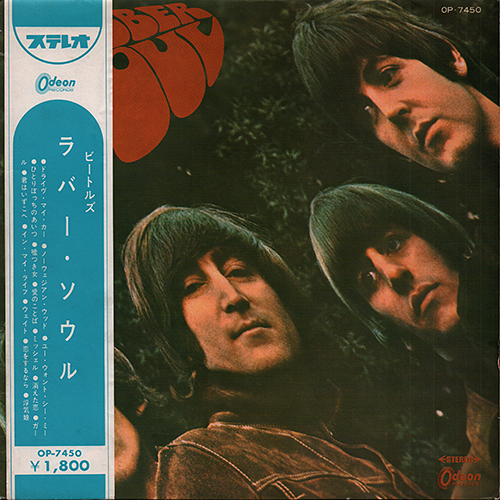 |
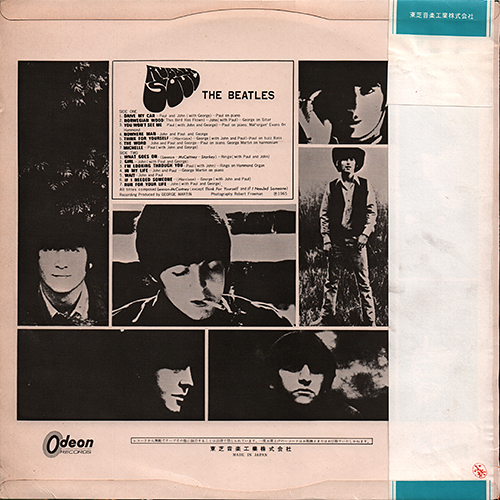 |
 |
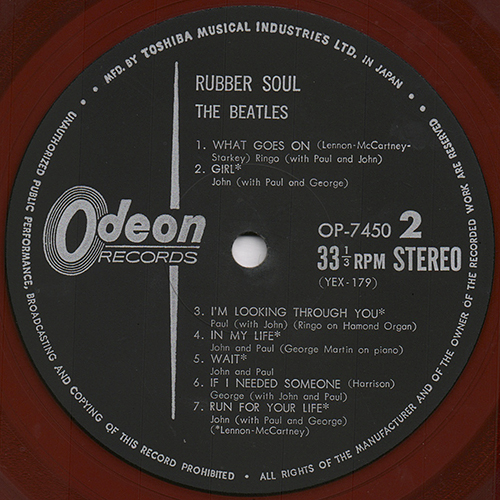 |
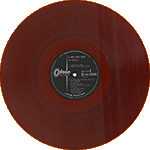 |
|
| INNER SLEEVE |
INNER SLEEVE CLOSE UP |
||||
| FRONT --> Click! | BACK --> Click! | ||||
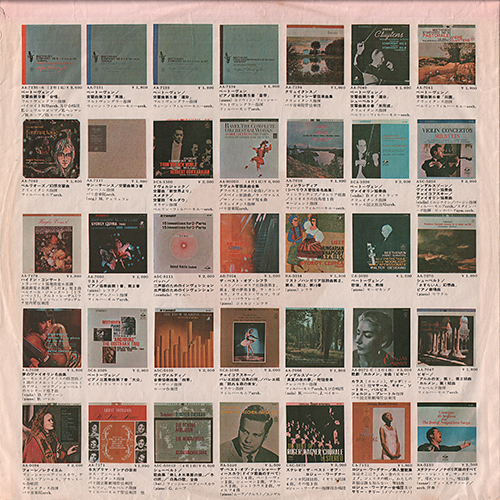 |
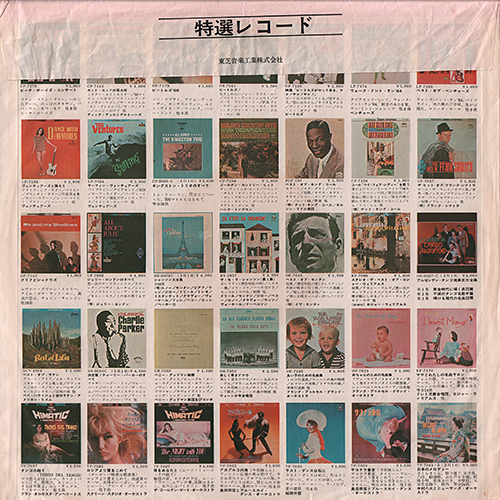 |
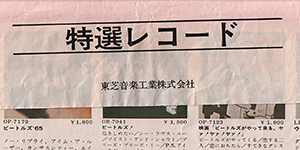 |
The original colour "advert" inner bag has a fold-over flap at the top of the bag to prevent the record from falling out. | ||
|
LYRIC
SHEET (Bifold Type)
|
|||||
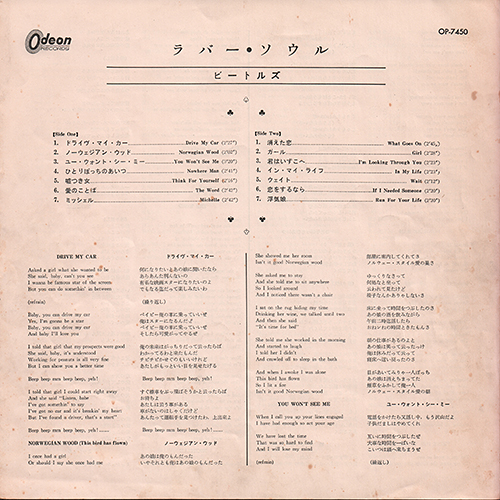 |
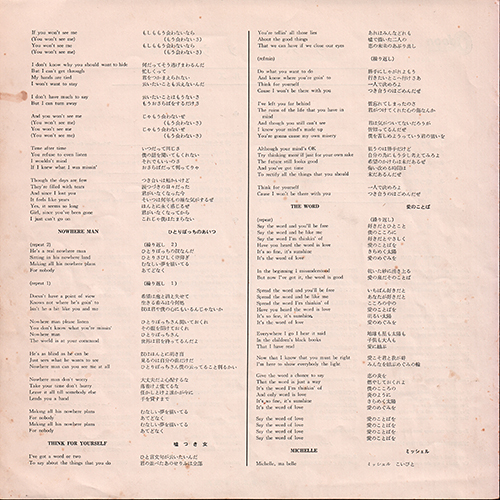 |
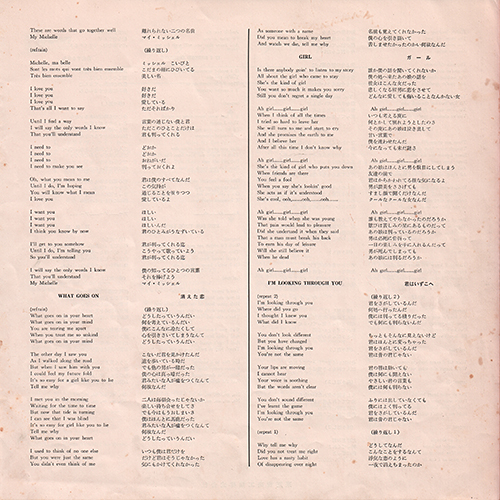 |
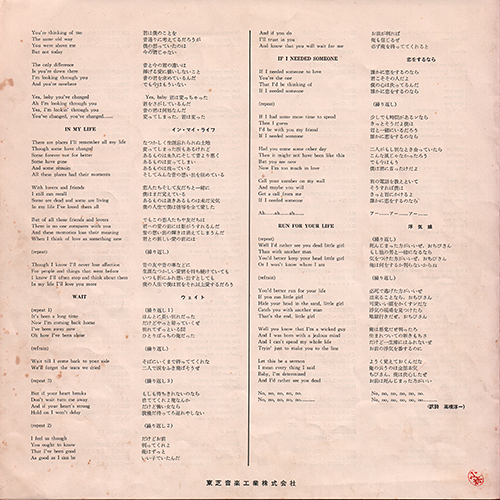 |
The lyric sheet is bifold type. | |
| LYRIC SHEET CLOSE
UP |
|||||
 |
 |
 |
Translation: Junichi
Takahashi. "Toshiba Musical Industries Ltd." was printed on the lyric sheet. |
||
| Light Blue OBI CLOSE UP | |||||
| FRONT --> Click! | BACK --> Click! | ||||
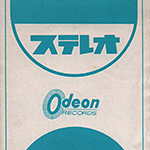 |
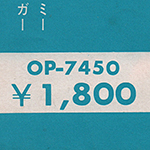 |
1st. pressing had a light blue / white OBI
and priced ¥1,800 on obi strip. The word "STEREO (Japanese)"
and Odeon logo mark and catalog number "OP-7450" were
printed on the front. |
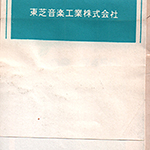 |
There is no order sheet on the
back side of the Obi. |
|
| FRONT AND BACK COVER CLOSE UP | |||||
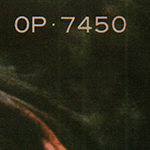 |
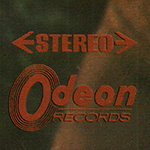 |
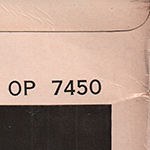 |
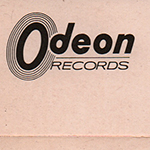 |
Odeon logo mark and catalog number "OP 7450" were printed
on both sides of the cover. |
|
| BACK COVER CLOSE UP | |||||
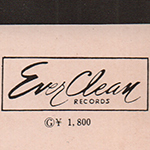 |
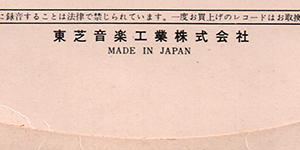 |
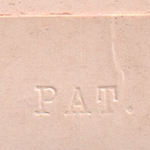 |
"EverClean" logo,
"G-¥1,800", and "Toshiba Musical Industries Ltd." were
printed at the bottom of the back cover. The words "PAT." was embossed at the bottom of the back cover. |
||
| BACK COVER CLOSE UP | |||||
 |
The
credit
"Recording Produced by GEORGE MARTIN" and "Photography
Robert Freeman" were printed at the back cover. |
||||
| LABEL CLOSE UP | |||||
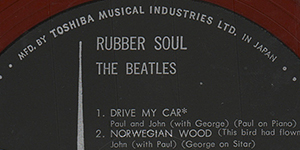 |
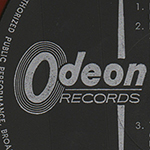 |
Toshiba
pressed a lot of their records on red, "Everclean" vinyl
from 1958 through 1974 (maybe). The Everclean vinyl
was designed to be less prone to collecting static
electricity and dust than the more common black vinyl. The
words "MFD. BY TOSHIBA MUSICAL INDUSTRIES LTD. IN JAPAN" was
printed at the perimeter. |
|||
| LABEL CLOSE UP | |||||
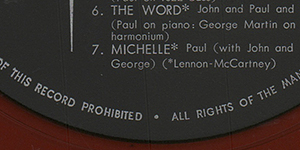 |
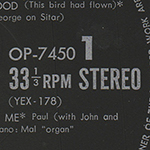 |
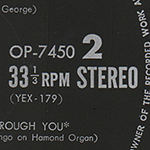 |
The words "LONG PLAYING"
was erased at the bottom of the label. Catalog number and matrix number were printed at the right side of the center hole. |
||
|
OTHER ITEM
|
|||||
| - |
|||||
| RECORD LABEL | Odeon Label Type-2 (without the words "LONG
PLAYING") |
||||
| MIX | STEREO |
||||
| MATRIX No. | SIDE 1 | YEX-178 11 |
|||
| SIDE 2 | YEX-179 13 | ||||
| PRESS MARK | B6 |
||||
| VINYL COLOR | RED |
||||
| RECORD COMPANY'S NAME | SLEEVE | Toshiba
Ongaku kogyo Kabusikigaisha |
|||
| LABEL | MFD. BY
TOSHIBA MUSICAL INDUSTRIES LTD. IN JAPAN |
||||
| SYMBOL/PRICE | G - ¥1,800 |
||||
| LYRIC SHEET STYLE | Bifold Type |
||||
| COVER FORM | Single type. Full laminated soft cover. |
||||
| INNER SLEEVE |
The original colour "advert" inner bag
Type-2 |
||||
| OBI |
Light blue Obi / without Order sheet |
||||
| COVER DESIGN/ PHOTO/ NOTES | Photography Robert Freeman Translation: Junichi Takahashi |
||||
|
COMMENTS
|
Black Odeon label with
silver print. The words "LONG PLAYING" was erased at the bottom of the label. Toshiba released the first Japanese record featuring the Beatles. When this record was released, Toshiba's official name was "Toshiba Musical Industries Ltd." and they used the Odeon label for this and subsequent Beatles releases. Red vinyl: Besides good sound and quality printing, Japanese records also offered some other things of interest to the collector. One of the primary manufacturing companies in Japan, Toshiba, pressed a lot of their records on red, “Everclean” vinyl from 1958 through 1974 (maybe). While not pressed as collectors’ items, these red vinyl pressings are more sought out by collectors than their black vinyl counterparts. The Everclean vinyl was designed to be less prone to collecting static electricity and dust than the more common black vinyl. The obi: "Light blue" Obi It is light blue / white in design with light blue background with the half circle on top. It also features an Odeon logo, catalogue number and price information. While most Japanese records feature local music, a lot of music fans there like foreign music, as well. The language barrier in Japan presented a problem – should foreign album covers be changed for Japanese albums? The solution was the obi, which means “belt” or “sash”. The obi is a strip of paper, usually about two inches wide, that wraps vertically around the album cover, containing information about the artist and album in Japanese. As these strips of paper were fragile and easily torn, they are often missing, especially since consumers in the 1950s and 1960s attached little significance to them. Finding Japanese records made prior to 1970 that still have the obi intact can be quite difficult, and for some albums, nearly impossible. The inclusion of the obi can dramatically affect the price of some Japanese records, sometimes increasing the price by a factor of ten. |
||||
| TITLE | RUBBER SOUL |
||||
| CATALOG NUMBER | OP-8156 |
||||
| RELEASE DATE | February 1969? / Second Press |
||||
| TRACK LISTING | SIDE 1 | SIDE 2 | |||
| Drive My Car |
What Goes On |
||||
| Norwegian Wood (This Bird Has Flown) |
Girl |
||||
| You Won't See Me |
I'm Looking Through You |
||||
| Nowhere Man |
In My Life |
||||
| Think For Yourself |
Wait |
||||
| The Word |
If I Needed Someone |
||||
| Michelle |
Run For Your Life |
||||
| FRONT --> Click! | BACK --> Click! | SIDE 1 --> Click! | SIDE 2 --> Click! | DISK | |
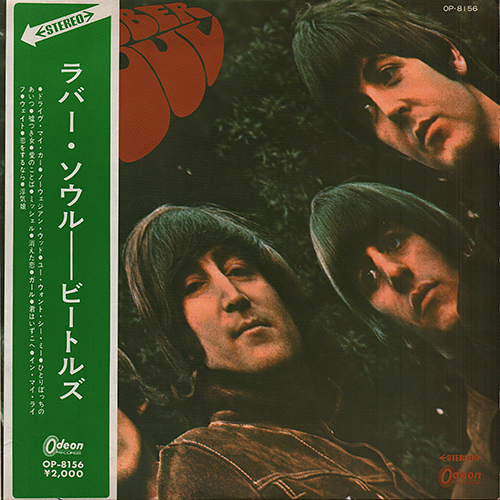 |
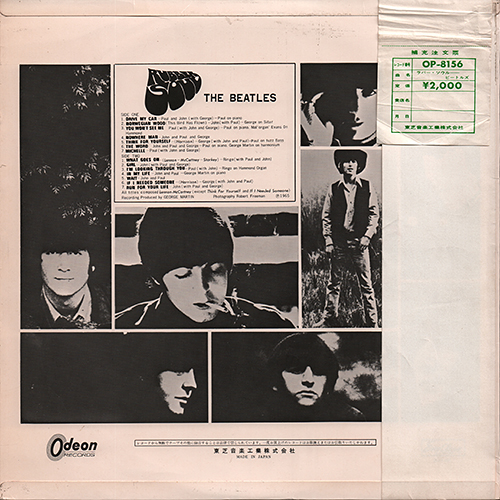 |
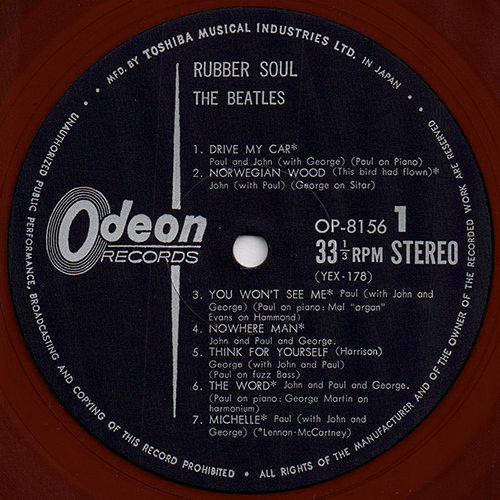 |
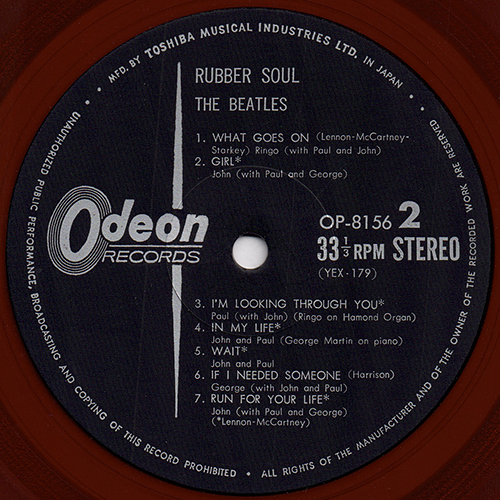 |
 |
|
| INNER SLEEVE |
INNER SLEEVE CLOSE UP |
||||
| FRONT --> Click! | BACK --> Click! | ||||
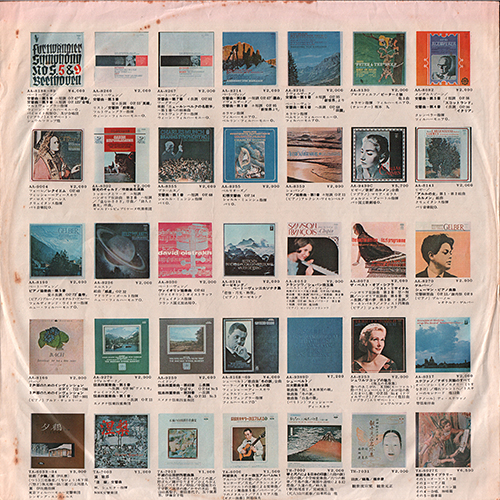 |
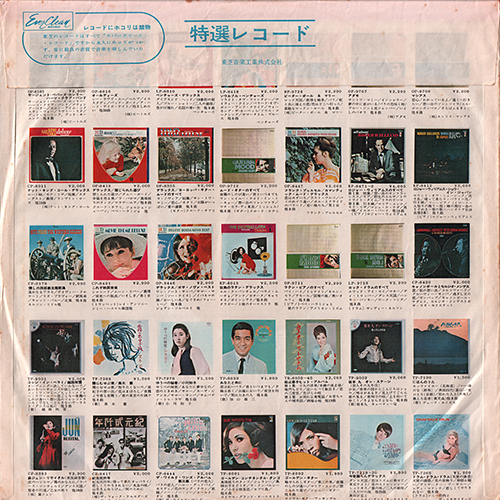 |
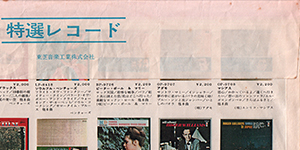 |
The original colour "advert" inner bag has a fold-over flap at the top of the bag to prevent the record from falling out. | ||
|
LYRIC
SHEET (Bifold Type)
|
|||||
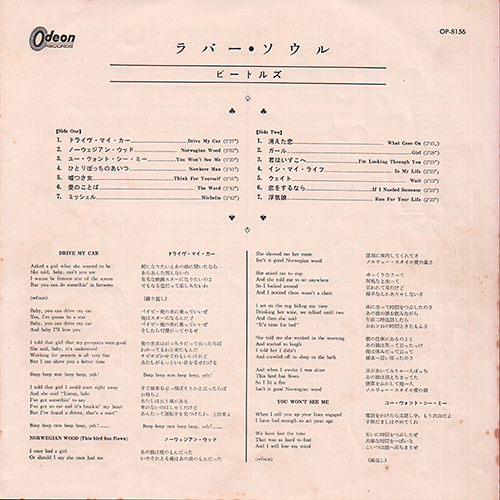 |
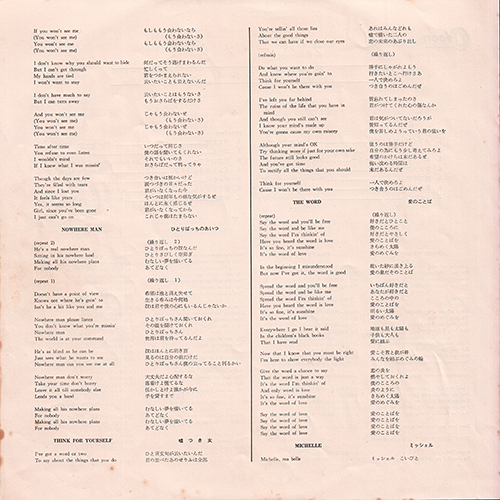 |
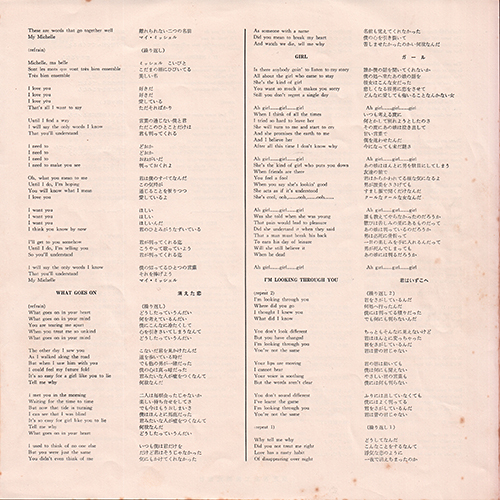 |
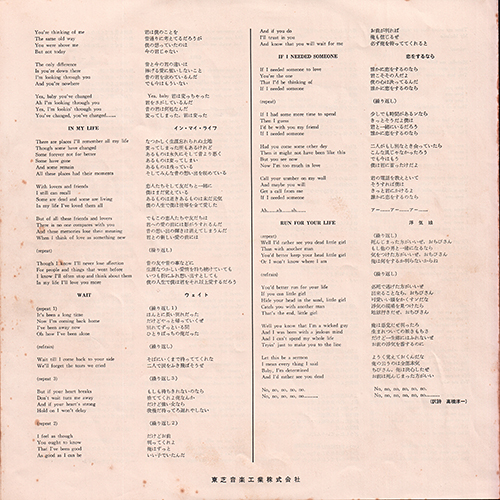 |
The lyric sheet is bifold type. | |
| LYRIC SHEET CLOSE
UP |
|||||
 |
 |
 |
Translation: Junichi
Takahashi. "Toshiba Musical Industries Ltd." was printed on the lyric sheet. |
||
| Odeon Green Arrow OBI CLOSE UP | |||||
| FRONT --> Click! | BACK --> Click! | ||||
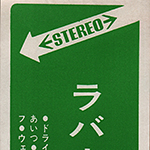 |
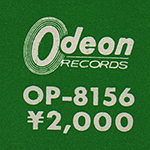 |
2nd. pressing had a green "arrow" OBI and
priced ¥2,000 on obi strip. The word "STEREO" and Odeon logo
mark and catalog number "OP-8156" were printed on the front. |
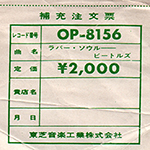 |
The obi remains intactwith
the order form on the back uncut. |
|
| FRONT AND BACK COVER CLOSE UP | |||||
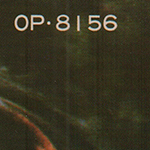 |
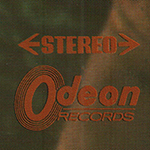 |
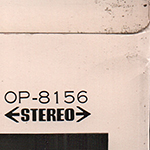 |
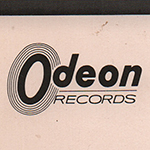 |
Odeon logo mark and catalog number "OP-8156" were printed
on both sides of the cover. |
|
| BACK COVER CLOSE UP | |||||
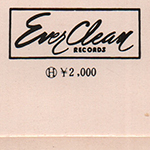 |
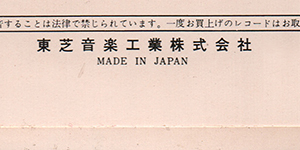 |
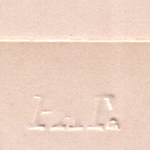 |
"EverClean" logo,
"H-¥2,000", and "Toshiba Musical Industries Ltd." were
printed at the bottom of the back cover. The words "PAT. (italic type)" was embossed at the bottom of the back cover. |
||
| BACK COVER CLOSE UP | |||||
 |
The
credit
"Recording Produced by GEORGE MARTIN" and "Photography
Robert Freeman" were printed at the back cover. |
||||
| LABEL CLOSE UP | |||||
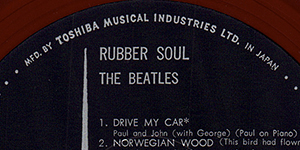 |
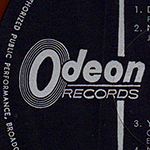 |
Toshiba
pressed a lot of their records on red, "Everclean" vinyl
from 1958 through 1974 (maybe). The Everclean vinyl
was designed to be less prone to collecting static
electricity and dust than the more common black vinyl. The
words "MFD. BY TOSHIBA MUSICAL INDUSTRIES LTD. IN JAPAN" was
printed at the perimeter. |
|||
| LABEL CLOSE UP | |||||
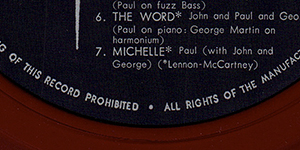 |
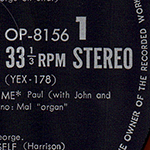 |
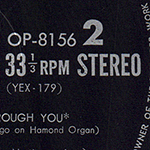 |
The words "LONG PLAYING"
was erased at the bottom of the label. Catalog number and matrix number were printed at the right side of the center hole. |
||
|
OTHER ITEM
|
|||||
| - |
|||||
| RECORD LABEL | Odeon Label Type-2 (without the words "LONG
PLAYING") |
||||
| MIX | STEREO |
||||
| MATRIX No. | SIDE 1 | YEX-178 41 |
|||
| SIDE 2 | YEX-179 30 |
||||
| PRESS MARK | 9B |
||||
| VINYL COLOR | RED |
||||
| RECORD COMPANY'S NAME | SLEEVE | Toshiba
Ongaku kogyo Kabusikigaisha |
|||
| LABEL | MFD. BY
TOSHIBA MUSICAL INDUSTRIES LTD. IN JAPAN |
||||
| SYMBOL/PRICE | H - ¥2,000 |
||||
| LYRIC SHEET STYLE | Bifold Type |
||||
| COVER FORM | Single type. Full laminated soft cover. |
||||
| INNER SLEEVE |
The original colour "advert" inner bag
Type-7 |
||||
| OBI |
Green / white so called "Odeon Arrow" OBI |
||||
| COVER DESIGN/ PHOTO/ NOTES | Photography Robert Freeman Translation: Junichi Takahashi |
||||
|
COMMENTS
|
Black Odeon label with
silver print. The words "LONG PLAYING" was erased at the bottom of the label. Taking advantage of the rise in LP prices in 1967, the price of a stereo LP rose to 2,000 yen. Already released Beatles LPs have been reissued with the record number changed to OP-8,000, and the obi changed to an arrow obi. The alphabet symbol and price display on the back of the cover have also been changed to "H ¥2,000". Red vinyl: Besides good sound and quality printing, Japanese records also offered some other things of interest to the collector. One of the primary manufacturing companies in Japan, Toshiba, pressed a lot of their records on red, “Everclean” vinyl from 1958 through 1974 (maybe). While not pressed as collectors’ items, these red vinyl pressings are more sought out by collectors than their black vinyl counterparts. The Everclean vinyl was designed to be less prone to collecting static electricity and dust than the more common black vinyl. The obi: A. K. A."Arrow" Obi 2nd. pressing had a green / white so called "Arrow" OBI and priced ¥2000 on rear sleeve and obi strip. On June 1967, starting with "Oldies (OP-8016)", numbering for new Odeon LPs changed to the 8000 range numbers. So Obis were renew, A.K.A. Odeon "Arrow Obi" in green and with the same design as the Apple Obis. While most Japanese records feature local music, a lot of music fans there like foreign music, as well. The language barrier in Japan presented a problem – should foreign album covers be changed for Japanese albums? The solution was the obi, which means “belt” or “sash”. The obi is a strip of paper, usually about two inches wide, that wraps vertically around the album cover, containing information about the artist and album in Japanese. As these strips of paper were fragile and easily torn, they are often missing, especially since consumers in the 1950s and 1960s attached little significance to them. Finding Japanese records made prior to 1970 that still have the obi intact can be quite difficult, and for some albums, nearly impossible. The inclusion of the obi can dramatically affect the price of some Japanese records, sometimes increasing the price by a factor of ten. |
||||
| TITLE | RUBBER SOUL |
||||
| CATALOG NUMBER | AP-8156 |
||||
| RELEASE DATE | May 1969? / Third Press |
||||
| TRACK LISTING | SIDE 1 | SIDE 2 | |||
| Drive My Car |
What Goes On |
||||
| Norwegian Wood (This Bird Has Flown) |
Girl |
||||
| You Won't See Me |
I'm Looking Through You |
||||
| Nowhere Man |
In My Life |
||||
| Think For Yourself |
Wait |
||||
| The Word |
If I Needed Someone |
||||
| Michelle |
Run For Your Life |
||||
| FRONT --> Click! | BACK --> Click! | SIDE 1 --> Click! | SIDE 2 --> Click! | DISK | |
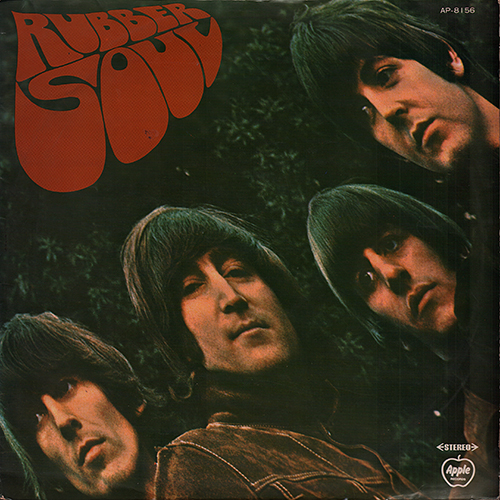 |
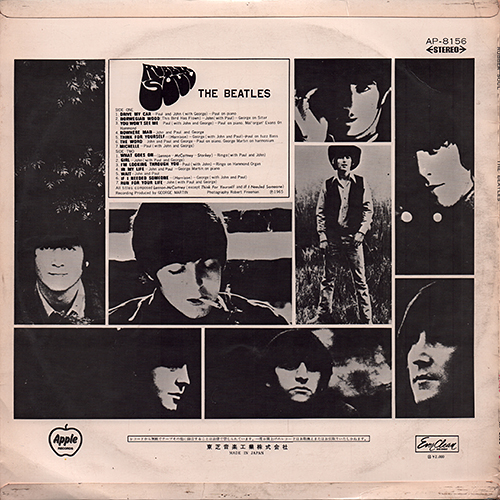 |
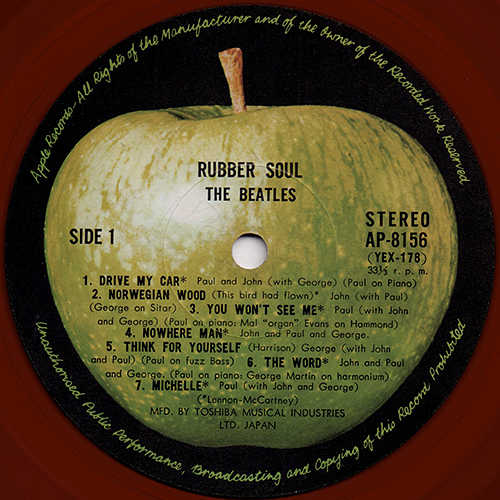 |
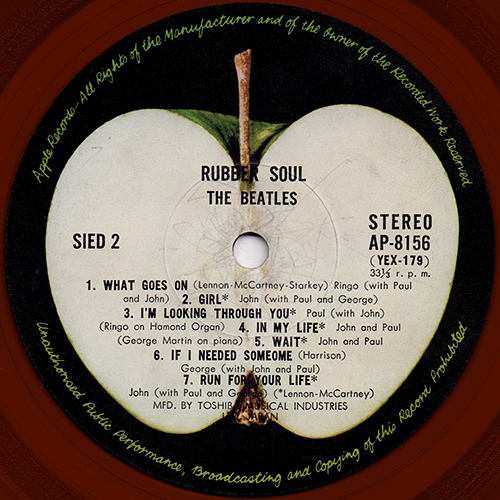 |
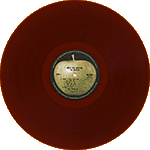 |
|
| INNER SLEEVE | LYRIC SHEET (Bifold Type) | ||||
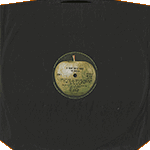 |
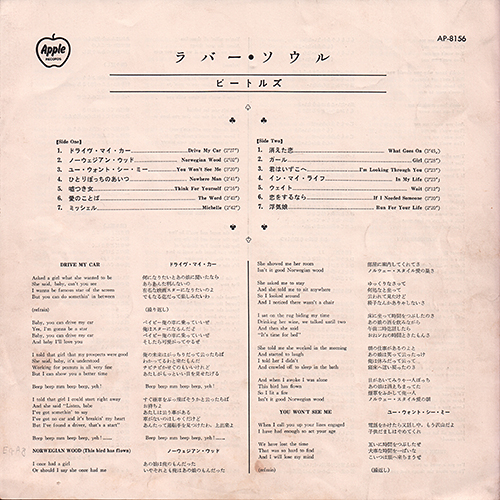 |
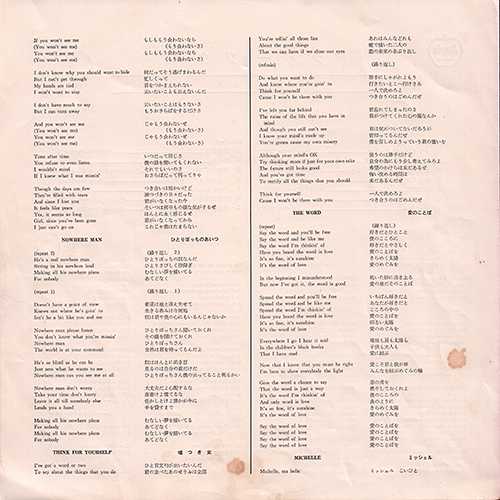 |
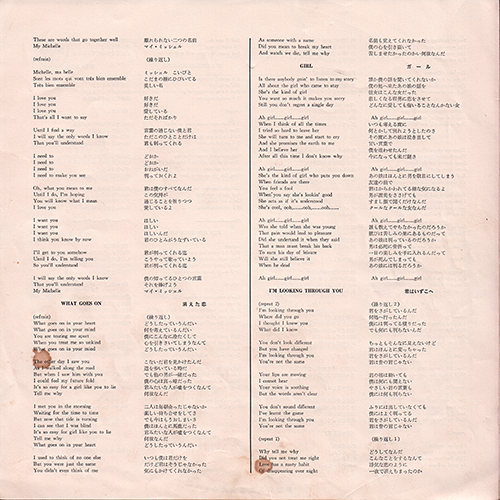 |
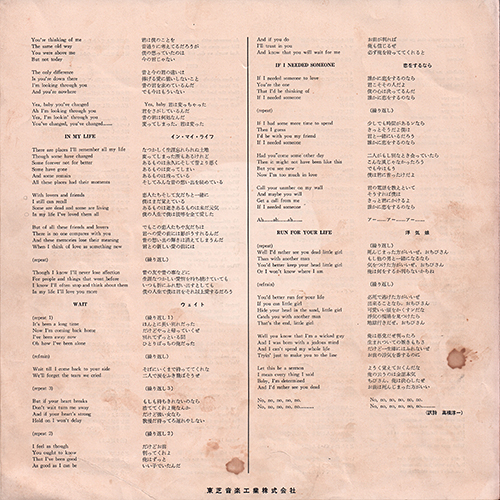 |
|
| LYRIC SHEET CLOSE
UP |
|||||
 |
 |
 |
Translation: Junichi
Takahashi. "Toshiba Musical Industries Ltd." was printed on the lyric sheet. |
||
| Apple Green Arrow OBI CLOSE UP | |||||
| FRONT | BACK | ||||
| Sorry, I don't have it. 3rd. pressing had a green "arrow" OBI and priced ¥2,000 on obi strip. |
|||||
| FRONT AND BACK COVER CLOSE UP | |||||
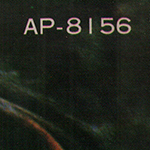 |
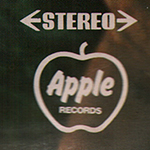 |
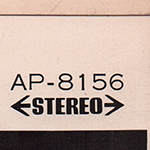 |
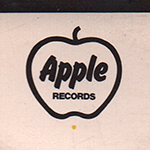 |
Apple logo mark and catalog number were printed at the
both sides of the sleeve. |
|
| BACK COVER CLOSE UP | |||||
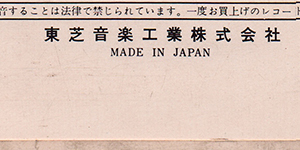 |
Single type.
Full laminated soft cover. Twin-flipback cover (straight type). "Toshiba Musical Industries Ltd." and "H-¥2,000" were printed at the bottom of the back cover. |
||||
| BACK COVER CLOSE UP | |||||
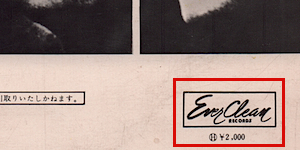 |
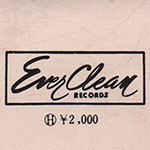 |
"Ever Clean" logo mark was printed at the bottom of the right corner on the back cover. | |||
| LABEL CLOSE UP | |||||
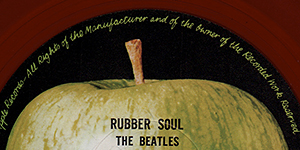 |
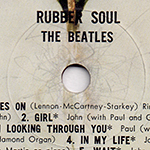 |
In 1969,
Toshiba had to reissue on the Apple label all the records
previously issued on the Odeon label. The phrase "Apple Records - All Rights of the Manufacturer and of the Owner of the Recorded work Reserved." was printed at the perimeter. |
|||
| LABEL CLOSE UP | |||||
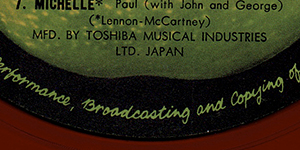 |
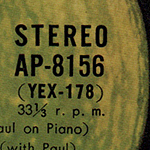 |
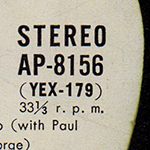 |
The words "MFD. BY TOSHIBA
MUSICAL INDUSTRIES LTD. JAPAN" was printed at the bottom of
the label. Catalog number "AP-8156" and matrix number were printed at the right side of the center hole. |
||
|
OTHER ITEM
|
|||||
| - |
|||||
| RECORD LABEL | Dark Green Apple label Type-1 |
||||
| MIX | STEREO |
||||
| MATRIX No. | SIDE 1 | YEX-178 44 |
|||
| SIDE 2 | YEX-179 34 |
||||
| PRESS MARK | 9E |
||||
| VINYL COLOR | RED |
||||
| RECORD COMPANY'S NAME | SLEEVE | Toshiba
Ongaku kogyo Kabusikigaisha |
|||
| LABEL | MFD. BY
TOSHIBA MUSICAL INDUSTRIES LTD. JAPAN |
||||
| SYMBOL/PRICE | H - ¥2,000 |
||||
| LYRIC SHEET STYLE | Bifold Type |
||||
| COVER FORM | Single type. Full laminated soft cover. Twin-flipback cover (straight type) |
||||
| INNER SLEEVE |
Apple custom black sleeve |
||||
| OBI |
Green / white so called "Apple Arrow" OBI |
||||
| COVER DESIGN/ PHOTO/ NOTES | Photography Robert Freeman Translation: Junichi Takahashi |
||||
|
COMMENTS
|
Dark green Apple label
Type-1with black print. In late (September?)1969, Toshiba had to reissue on the Apple label all the records previously issued on the Odeon label. And in the Apple label, there are two subtypes, TOSHIBA MUSIC and TOSHIBA EMI. Further more, the early copies of the APPLE-TOSHIBA MUSIC type have dark Apple on its label, though the late copies have light one. Red vinyl: Besides good sound and quality printing, Japanese records also offered some other things of interest to the collector. One of the primary manufacturing companies in Japan, Toshiba, pressed a lot of their records on red, “Everclean” vinyl from 1958 through 1974 (maybe). While not pressed as collectors’ items, these red vinyl pressings are more sought out by collectors than their black vinyl counterparts. The Everclean vinyl was designed to be less prone to collecting static electricity and dust than the more common black vinyl. This LP was manufactured two ways: both Black and Red vinyl. "Ever Clean" logo mark was printed at the bottom of the right corner on the back cover. The obi: A. K. A."Arrow" Obi 4th. and 5th. pressings had a green / white so called "Arrow" OBI and priced ¥2000 on rear sleeve and obi strip. On June 1967, starting with "Oldies (OP-8016)", numbering for new Odeon LPs changed to the 8000 range numbers. So Obis were renew, A.K.A. Odeon "Arrow Obi" in green and with the same design as the Apple Obis. While most Japanese records feature local music, a lot of music fans there like foreign music, as well. The language barrier in Japan presented a problem – should foreign album covers be changed for Japanese albums? The solution was the obi, which means “belt” or “sash”. The obi is a strip of paper, usually about two inches wide, that wraps vertically around the album cover, containing information about the artist and album in Japanese. As these strips of paper were fragile and easily torn, they are often missing, especially since consumers in the 1950s and 1960s attached little significance to them. Finding Japanese records made prior to 1970 that still have the obi intact can be quite difficult, and for some albums, nearly impossible. The inclusion of the obi can dramatically affect the price of some Japanese records, sometimes increasing the price by a factor of ten. |
||||
| TITLE | RUBBER SOUL |
||||
| CATALOG NUMBER | AP-8156 |
||||
| RELEASE DATE | February 1971? / 4th. Press |
||||
| TRACK LISTING | SIDE 1 | SIDE 2 | |||
| Drive My Car |
What Goes On |
||||
| Norwegian Wood (This Bird Has Flown) |
Girl |
||||
| You Won't See Me |
I'm Looking Through You |
||||
| Nowhere Man |
In My Life |
||||
| Think For Yourself |
Wait |
||||
| The Word |
If I Needed Someone |
||||
| Michelle |
Run For Your Life |
||||
| FRONT --> Click! | BACK --> Click! | SIDE 1 --> Click! | SIDE 2 --> Click! | DISK | |
 |
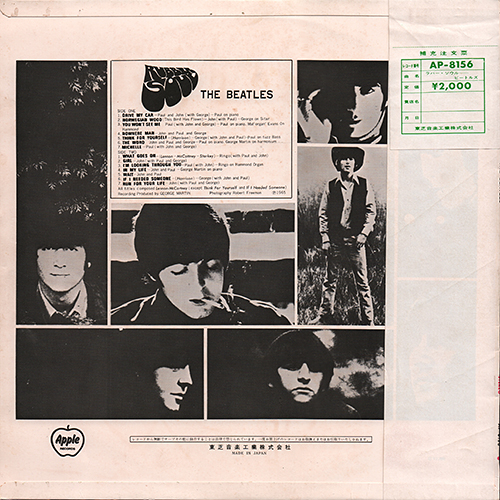 |
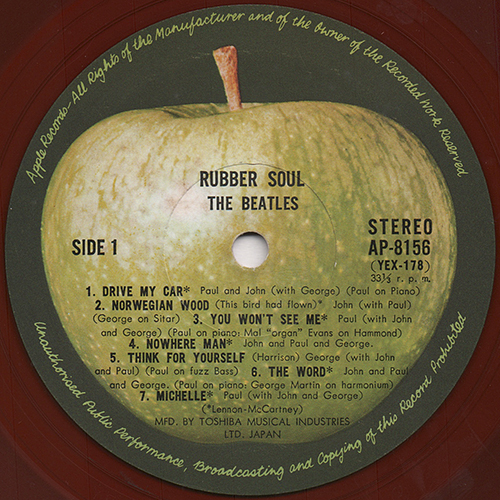 |
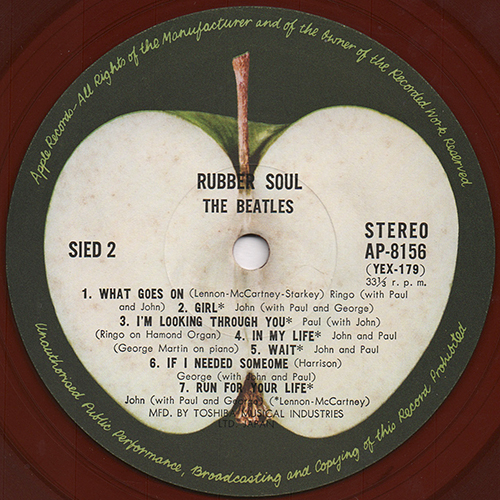 |
 |
|
| INNER SLEEVE | LYRIC SHEET (Bifold Type) | ||||
 |
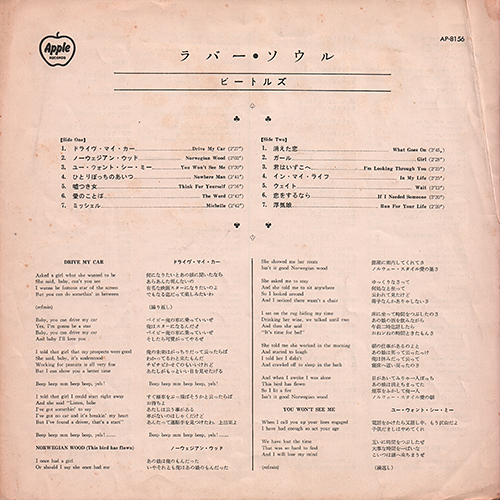 |
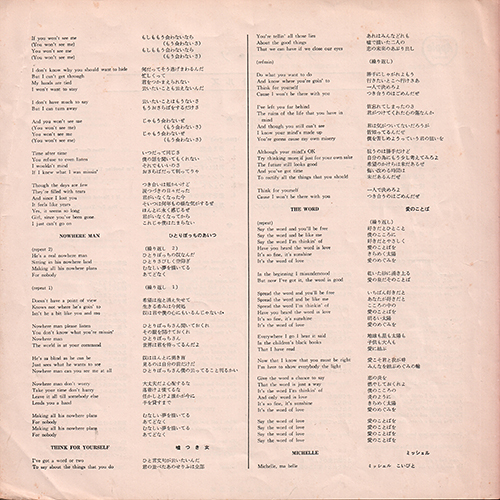 |
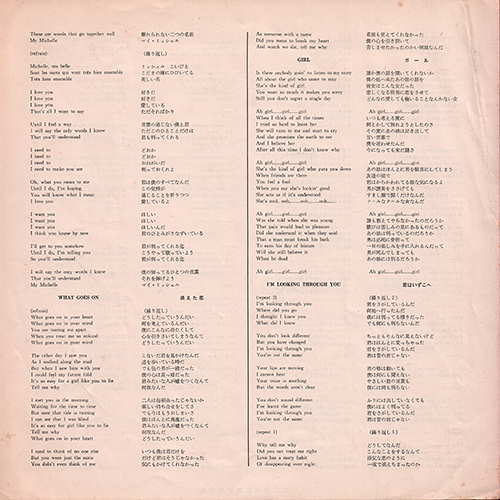 |
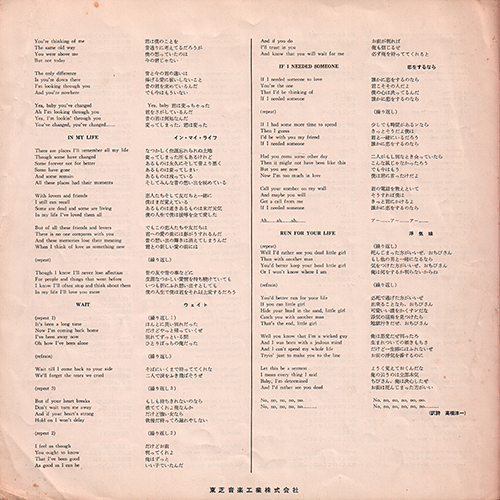 |
|
| LYRIC SHEET CLOSE
UP |
|||||
 |
 |
 |
Translation: Junichi
Takahashi. "Toshiba Musical Industries Ltd." was printed on the lyric sheet. |
||
| Apple Green Arrow OBI CLOSE UP | |||||
| FRONT | BACK --> Click! | ||||
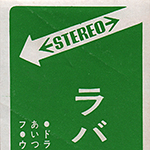 |
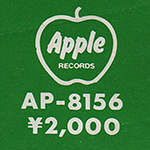 |
3rd. pressing had a green "arrow"
OBI and priced ¥2,000 on obi strip. |
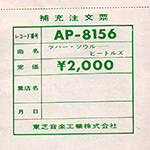 |
There is order sheet on
the back side of the Obi. |
|
| FRONT AND BACK COVER CLOSE UP | |||||
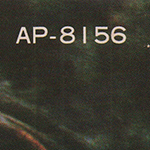 |
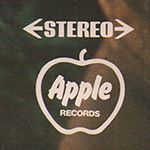 |
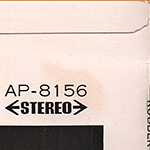 |
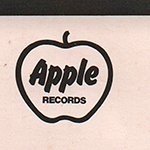 |
Apple logo mark and catalog number were printed at the
both sides of the sleeve. |
|
| BACK COVER CLOSE UP | |||||
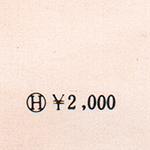 |
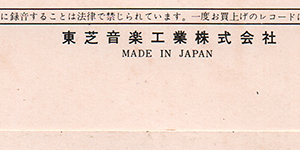 |
Single type. Full laminated soft cover. Twin-flipback cover (straight type). "Toshiba Musical Industries Ltd." and "H-¥2,000" were printed at the bottom of the back cover. "Ever Clean" logo mark was removed on the back cover. |
|||
| BACK COVER CLOSE UP | |||||
 |
The
credit
"Recording Produced by GEORGE MARTIN" and "Photography
Robert Freeman" were printed at the back cover. |
||||
| LABEL CLOSE UP | |||||
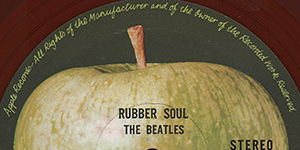 |
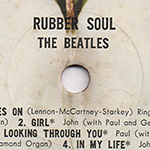 |
In 1969,
Toshiba had to reissue on the Apple label all the records
previously issued on the Odeon label. The phrase "Apple Records - All Rights of the Manufacturer and of the Owner of the Recorded work Reserved." was printed at the perimeter. |
|||
| LABEL CLOSE UP | |||||
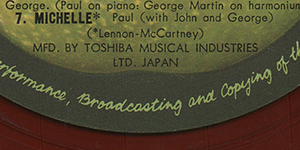 |
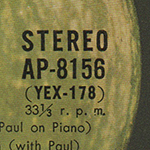 |
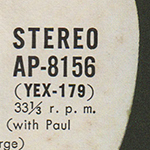 |
The words "MFD. BY TOSHIBA
MUSICAL INDUSTRIES LTD. JAPAN" was printed at the bottom of
the label. Catalog number "AP-8156" and matrix number were printed at the right side of the center hole. |
||
|
OTHER ITEM
|
|||||
| - |
|||||
| RECORD LABEL | Dark Green Apple label Type-1 |
||||
| MIX | STEREO |
||||
| MATRIX No. | SIDE 1 | YEX-178-Z 1S 7 |
|||
| SIDE 2 | YEX-179
2S
7 |
||||
| PRESS MARK | A1
-> B1 |
||||
| VINYL COLOR | RED |
||||
| RECORD COMPANY'S NAME | SLEEVE | Toshiba
Ongaku kogyo Kabusikigaisha |
|||
| LABEL | MFD. BY
TOSHIBA MUSICAL INDUSTRIES LTD. JAPAN |
||||
| SYMBOL/PRICE | H - ¥2,000 |
||||
| LYRIC SHEET STYLE | Bifold Type |
||||
| COVER FORM | Single type. Full laminated soft cover. Twin-flipback cover (straight type) |
||||
| INNER SLEEVE |
Apple custom black sleeve |
||||
| OBI |
Green / white so called "Apple Arrow" OBI |
||||
| COVER DESIGN/ PHOTO/ NOTES | Photography Robert Freeman Translation: Junichi Takahashi |
||||
|
COMMENTS
|
Dark green Apple label
Type-1with black print. In late (September?)1969, Toshiba had to reissue on the Apple label all the records previously issued on the Odeon label. And in the Apple label, there are two subtypes, TOSHIBA MUSIC and TOSHIBA EMI. Further more, the early copies of the APPLE-TOSHIBA MUSIC type have dark Apple on its label, though the late copies have light one. Red vinyl: Besides good sound and quality printing, Japanese records also offered some other things of interest to the collector. One of the primary manufacturing companies in Japan, Toshiba, pressed a lot of their records on red, “Everclean” vinyl from 1958 through 1974 (maybe). While not pressed as collectors’ items, these red vinyl pressings are more sought out by collectors than their black vinyl counterparts. The Everclean vinyl was designed to be less prone to collecting static electricity and dust than the more common black vinyl. This LP was manufactured two ways: both Black and Red vinyl. The obi: A. K. A."Arrow" Obi 4th. and 5th. pressings had a green / white so called "Arrow" OBI and priced ¥2000 on rear sleeve and obi strip. On June 1967, starting with "Oldies (OP-8016)", numbering for new Odeon LPs changed to the 8000 range numbers. So Obis were renew, A.K.A. Odeon "Arrow Obi" in green and with the same design as the Apple Obis. While most Japanese records feature local music, a lot of music fans there like foreign music, as well. The language barrier in Japan presented a problem – should foreign album covers be changed for Japanese albums? The solution was the obi, which means “belt” or “sash”. The obi is a strip of paper, usually about two inches wide, that wraps vertically around the album cover, containing information about the artist and album in Japanese. As these strips of paper were fragile and easily torn, they are often missing, especially since consumers in the 1950s and 1960s attached little significance to them. Finding Japanese records made prior to 1970 that still have the obi intact can be quite difficult, and for some albums, nearly impossible. The inclusion of the obi can dramatically affect the price of some Japanese records, sometimes increasing the price by a factor of ten. |
||||
| TITLE | RUBBER SOUL |
||||
| CATALOG NUMBER | AP-8156 |
||||
| RELEASE DATE | May 1969? / CBS SONY Contract Press |
||||
| TRACK LISTING | SIDE 1 | SIDE 2 | |||
| Drive My Car |
What Goes On |
||||
| Norwegian Wood (This Bird Has Flown) |
Girl |
||||
| You Won't See Me |
I'm Looking Through You |
||||
| Nowhere Man |
In My Life |
||||
| Think For Yourself |
Wait |
||||
| The Word |
If I Needed Someone |
||||
| Michelle |
Run For Your Life |
||||
| FRONT --> Click! | BACK --> Click! | SIDE 1 --> Click! | SIDE 2 --> Click! | DISK | |
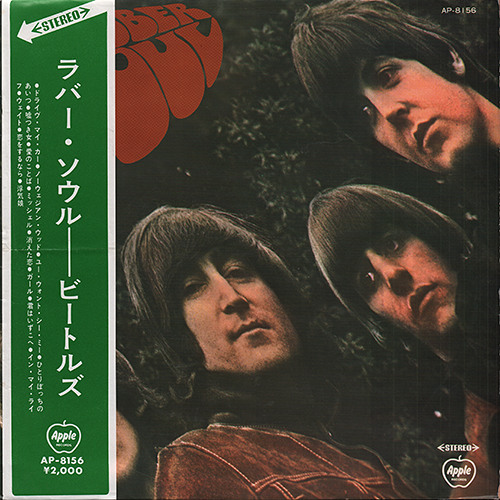 |
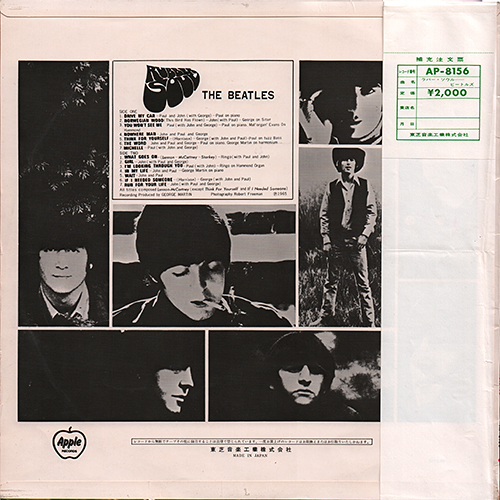 |
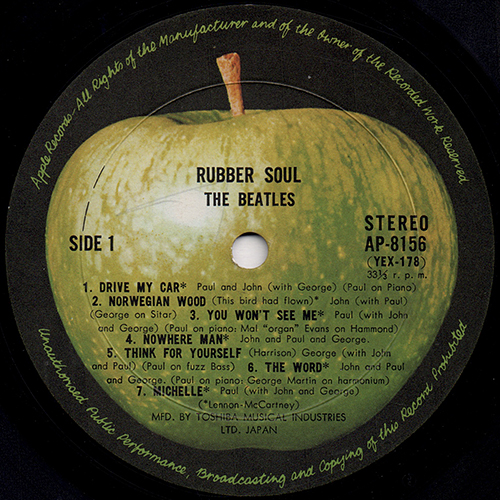 |
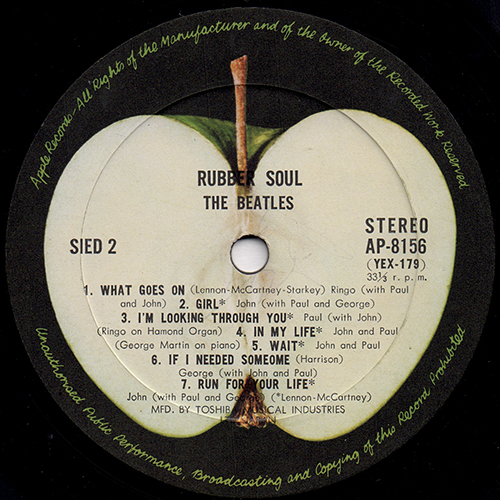 |
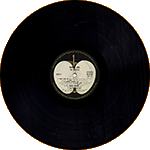 |
|
| INNER SLEEVE | LYRIC SHEET (Bifold Type) | ||||
 |
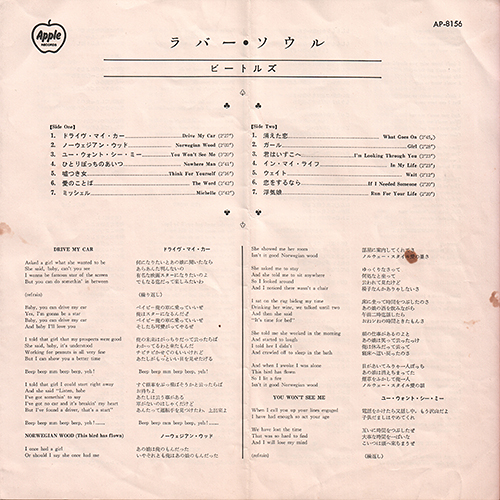 |
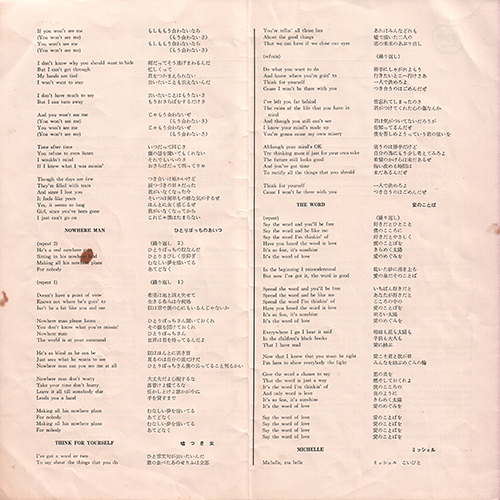 |
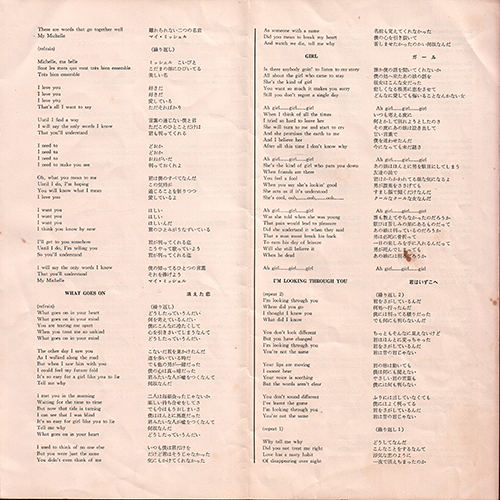 |
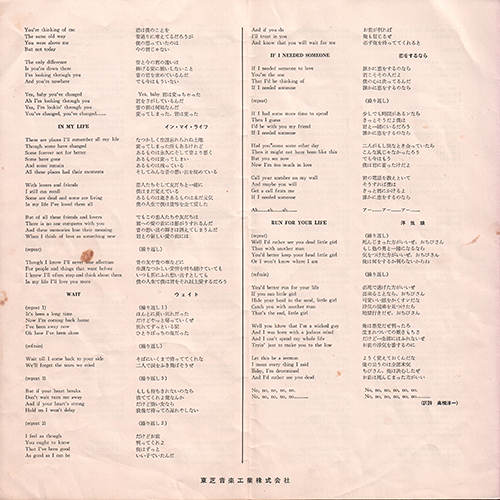 |
|
| LYRIC SHEET CLOSE
UP |
|||||
 |
 |
 |
Translation: Junichi
Takahashi. "Toshiba Musical Industries Ltd." was printed on the lyric sheet. |
||
| Apple Green Arrow OBI CLOSE UP | |||||
| FRONT | BACK --> Click! | ||||
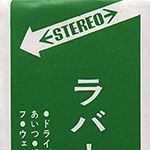 |
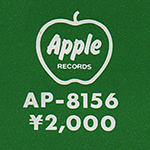 |
3rd. pressing had a green "arrow"
OBI and priced ¥2,000 on obi strip. |
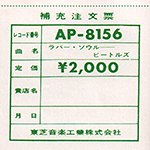 |
There is order sheet on
the back side of the Obi. |
|
| FRONT AND BACK COVER CLOSE UP | |||||
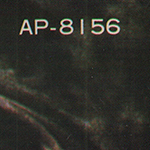 |
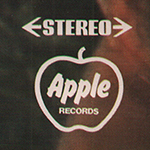 |
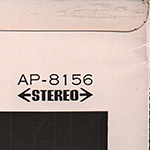 |
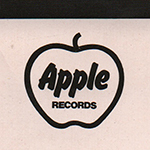 |
Apple logo mark and catalog number were printed at the
both sides of the sleeve. |
|
| BACK COVER CLOSE UP | |||||
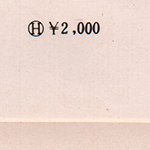 |
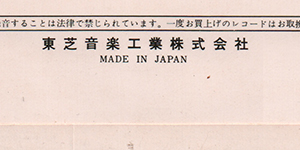 |
Single type. Full laminated soft cover. Twin-flipback cover (straight type). "Toshiba Musical Industries Ltd." and "H-¥2,000" were printed at the bottom of the back cover. "Ever Clean" logo mark was removed on the back cover. |
|||
| BACK COVER CLOSE UP | |||||
 |
The
credit
"Recording Produced by GEORGE MARTIN" and "Photography
Robert Freeman" were printed at the back cover. |
||||
| LABEL CLOSE UP | |||||
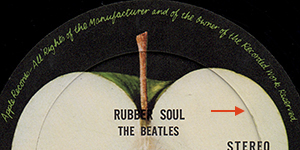 |
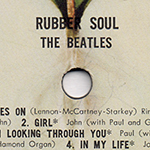 |
Sometimes
Toshiba had problems to press enough records to keep up with
the demand. To increase production they turned to other
companies (ex. Gramophone, Victor, King Records, and SONY) to press up
some copies of a particular release. The most promiment groove, which is a typical characteristic of CBS SONY LP presses is approximately 34.5mm out from the centre hole. |
|||
| LABEL CLOSE UP | |||||
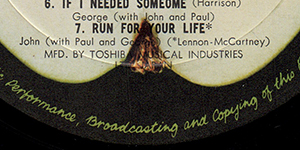 |
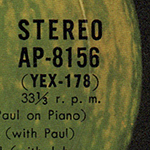 |
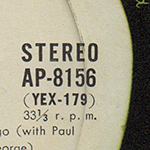 |
The words "MFD. BY TOSHIBA
MUSICAL INDUSTRIES LTD. JAPAN" was printed at the bottom of
the label. Catalog number "AP-8156" and matrix number were printed at the right side of the center hole. |
||
|
OTHER ITEM
|
|||||
| - |
|||||
| RECORD LABEL | Dark Green Apple label Type-1 / CBS SONY Contract Press |
||||
| MIX | STEREO |
||||
| MATRIX No. | SIDE 1 | YEX-178 45 |
|||
| SIDE 2 | YEX-179 42 |
||||
| PRESS MARK | E-9 |
||||
| VINYL COLOR | BLACK |
||||
| RECORD COMPANY'S NAME | SLEEVE | Toshiba
Ongaku kogyo Kabusikigaisha |
|||
| LABEL | MFD. BY
TOSHIBA MUSICAL INDUSTRIES LTD. JAPAN |
||||
| SYMBOL/PRICE | H - ¥2,000 |
||||
| LYRIC SHEET STYLE | Bifold Type |
||||
| COVER FORM | Single type. Full laminated soft cover. Twin-flipback cover (straight type) |
||||
| INNER SLEEVE |
Apple custom black sleeve |
||||
| OBI |
Green / white so called "Apple Arrow" OBI |
||||
| COVER DESIGN/ PHOTO/ NOTES | Photography Robert Freeman Translation: Junichi Takahashi |
||||
|
COMMENTS
|
Dark green Apple label
Type-1with black print. In late (September?)1969, Toshiba had to reissue on the Apple label all the records previously issued on the Odeon label. And in the Apple label, there are two subtypes, TOSHIBA MUSIC and TOSHIBA EMI. Further more, the early copies of the APPLE-TOSHIBA MUSIC type have dark Apple on its label, though the late copies have light one. Sometimes Toshiba had problems to press enough records to keep up with the demand. To increase production they turned to other companies (ex. Gramophone, Victor, King Records, and SONY) to press up some copies of a particular release. The most promiment groove, which is a typical characteristic of CBS SONY LP presses is approximately 34.5mm out from the centre hole. Red vinyl: Besides good sound and quality printing, Japanese records also offered some other things of interest to the collector. One of the primary manufacturing companies in Japan, Toshiba, pressed a lot of their records on red, “Everclean” vinyl from 1958 through 1974 (maybe). While not pressed as collectors’ items, these red vinyl pressings are more sought out by collectors than their black vinyl counterparts. The Everclean vinyl was designed to be less prone to collecting static electricity and dust than the more common black vinyl. This LP was manufactured two ways: both Black and Red vinyl. The obi: A. K. A."Arrow" Obi 4th. and 5th. pressings had a green / white so called "Arrow" OBI and priced ¥2000 on rear sleeve and obi strip. On June 1967, starting with "Oldies (OP-8016)", numbering for new Odeon LPs changed to the 8000 range numbers. So Obis were renew, A.K.A. Odeon "Arrow Obi" in green and with the same design as the Apple Obis. While most Japanese records feature local music, a lot of music fans there like foreign music, as well. The language barrier in Japan presented a problem – should foreign album covers be changed for Japanese albums? The solution was the obi, which means “belt” or “sash”. The obi is a strip of paper, usually about two inches wide, that wraps vertically around the album cover, containing information about the artist and album in Japanese. As these strips of paper were fragile and easily torn, they are often missing, especially since consumers in the 1950s and 1960s attached little significance to them. Finding Japanese records made prior to 1970 that still have the obi intact can be quite difficult, and for some albums, nearly impossible. The inclusion of the obi can dramatically affect the price of some Japanese records, sometimes increasing the price by a factor of ten. |
||||
